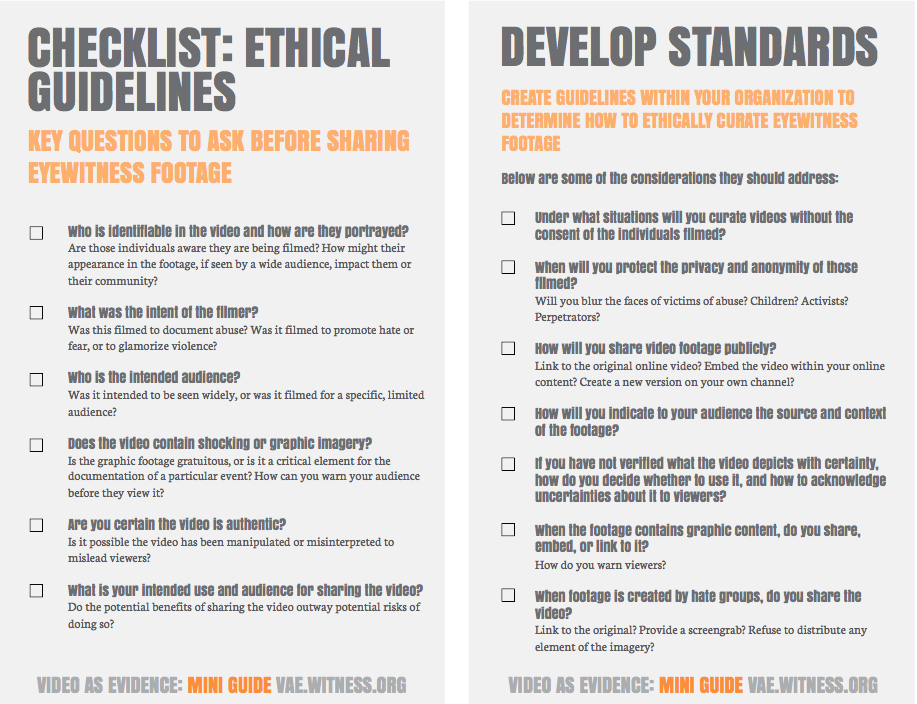Unlike a time when visual information was identified, captured and distributed almost exclusively by professionals, the increasing use of content produced by eyewitnesses is unveiling the potential and peril of such footage.
Questions about who is capturing images, who is featured in said images and whether or not consent is involved are only some of the things that Madeleine Bair, program manager of WITNESS Media Lab, said journalists should be considering.
“The question really comes down to how we apply traditional ethical practices to using this modern tool of eyewitness footage,” Bair said. “I think we should treat all eyewitness media with a dose of healthy journalism skepticism.”
In an effort to beginning addressing these questions, WITNESS, a Brooklyn-based international organization that trains and supports people in human rights video documentation, recently announced its Ethical Guidelines in Using Eyewitness Footage for Human Rights. Witness defines eyewitness footage as video taken at the scene of an incident by private people, including bystanders and people involved in the situation.In addition to tangible checklists, a variety of examples and situational commentary, the release of the WITNESS guidelines underscores the rising popularity and importance of eyewitness content.
“The ability for average citizens to document what they are experiencing or what their community is experiencing is really revolutionizing news gathering and human rights documentation,” Bair said. “It allows citizens to document what’s going on in real-time, and that gives a voice to so many more people and so many more places.”
Claire Wardle, co-founder of Eyewitness Media Hub, said not only does eyewitness content give voice to those who produce it, but it also has become an expectation by those who consume it. The organization is a nonprofit dedicated to exploring the ethical, legal and logistical use of user content in news.
“Up until relatively recently, news arrived and then you’d have the aftermath of an event. Now because almost everyone has a very high resolution camera in their pocket in the form of a phone, we’re now getting images of the actual event there and then,” she said.
This perceived demand has led to increased use of eyewitness media, though a 2014 study from Eyewitness Media Hub suggests that increased awareness about the legal and ethical dimensions of using such content has not yet been realized. The study found that photographs and videos featured in online newspaper articles were often presented inaccurately or used without permission.
And even if newsrooms may be making strides in seeking permission to republish, Wardle said, journalists tend to altogether ignore the consent of the individuals featured in the videos.
“In the human rights space, they’ve very strong on thinking about who’s actually in the videos or images,” she said. “Whereas from a journalism perspective, reporters are quicker to ask about who owns the rights to the content. The rights of the people in the videos or images is more of an afterthought.”
Wardle argues that despite the competitive environment of the 24-hour news cycle, obtaining consent of individuals in footage – even those shot by citizen journalists – is important.
“Putting out information that is inaccurate or unethical is not helpful for a newsroom business model,” she said. “I think it’s all about remaining competitive, yes, but also about being right. Even if the reason for abusing eyewitness content is business models, I think newsrooms will still have to start thinking a little bit more critically about how they use this kind of content.”
Wardle also said that just because information is posted publicly online or through social media, journalists should not assume the right to share the information more widely.
“Most people have no idea about what publication means. These platforms are all publishing platforms, but people haven’t thought that through when they’re posting to their 50 friends, they’re not in a million years thinking that it’s going to end up somewhere else,” she said. “I think over time, users will get more sophisticated and newsrooms will recognize that trust is more important to them as a brand.”
Besides taking points from ethical guidelines like those released by WITNESS, Wardle said that honoring the rights of individuals featured in eyewitness footage will really take off with a change in journalist mindsets.
“Journalists should always be thinking as if these eyewitnesses and featured individuals were a member of their family,” she said. “If this happened to a member of your family, how would they feel? And while, yes, journalists have to do their job, there is a way to do it in a way that is both sensitive and informative. It’s not all or nothing.”
Bair said she hopes that the WITNESS guidelines will be just one part of a larger conversation that will begin to address these ethical issues of using and sharing eyewitness content.
“It’s really about raising awareness and starting a discussion about how to put ethical standards into practice in a modern era of documentation,” she said. “That’s what we hope that these guidelines will really do.”
For Wardle, navigating the ethics of eyewitness journalism is simply an extension of the golden rule.
“Ultimately, the ethics of using eyewitness media comes down to how you treat people,” Wardle said. “When eyewitness media gets shared widely, there’s a responsibility, really, to think about the people who are caught up in that story.”

Checklist developed by WITNESS for eye witness footage of events. Used with permission. The guidelines are downloadable as a PDF from WITNESS.
